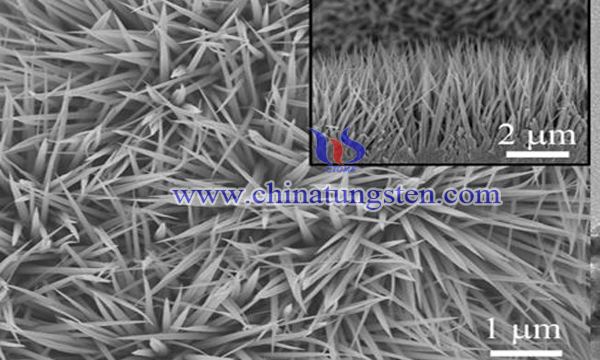A Simple Gas Sensing Material of Tungsten Oxide Nanowire by Hydrothermal Method
- Details
- Category: Tungsten Information
- Published on Friday, 08 November 2019 23:40
Through a simple hydrothermal method, the researchers prepared a wide range of tungsten oxide nanowire gas sensing materials on a large scale, and then provided a tungsten oxide nanowire sensor with high sensitivity, good repeatability and high stability for H2, CO and NH3. The operation process is as follows:

I.preparation of tungsten oxide nanowires:
(1)A certain amount of sodium tungstate is dissolved in a certain amount of deionized water to prepare a sodium tungstate solution with a weight ratio of 1.5-8.0%, which is magnetically stirred in an ice water bath for 1 hour to form a colorless and transparent sodium tungstate solution;
(2)Slowly add 3m / L hydrochloric acid to the solution in (1) and continuously stir for 1.5 hours to form a light yellow micelle solution. Centrifugate the micelle solution at a speed of 4000 rpm for 20 minutes;
(3)The product after centrifugation in (2) was evenly dispersed into an appropriate amount of 11.5m/l potassium sulfate solution to form a mixed solution. 80 ml of the mixed solution was transferred into a 100 ml reactor for hydrothermal reaction at a temperature of 180-270 ℃ and a reaction time of 12-120 hours.
(4)After the hydrothermal products in (3) were washed repeatedly by deionized water and anhydrous alcohol, and dried in air at 70 ℃ for 12 hours, the hexagonal tungsten oxide nanowires with high specific surface area were obtained, and the nanowires could maintain stable hexagonal structure below 450 ℃.
II.Gas sensing applications of tungsten oxide nanowires:
(1) Preparation of gas sensitive material slurry
Taking the prepared tungsten oxide nanowires as the main material, ethyl cellulose and terpineol as the adhesive, and adding a proper amount of glass material to enhance the adhesion between the sensitive material and the alumina substrate, the sensitive material slurry is prepared after the materials are mixed in proportion and stirred evenly.
(2) Component sintering
The slurry is screen printed on the alumina substrate with silver electrode and lead wire, dried in air at 80 ℃, sintered in a box furnace at 300-450 ℃ for 1-2 hours, and the gas sensor assembly of tungsten oxide nanowire is prepared.
(3) Component aging
The sintered gas sensing module was aged at 300 ℃ for 120 hours to make a tungsten oxide nanowire gas sensor.
The prepared tungsten oxide nanowires have large specific surface area and high thermal stability, and they have high sensitivity, good repeatability and high stability for low concentration (1-100ppm) H2, CO and NH3 in the field of gas sensing applications.
- Tungsten Oxide Manufacturer & Supplier, Chinatungsten Online: www.tungsten-oxide.com
- Tungsten News & Prices of China Tungsten Industry Association: www.ctia.com.cn
- Molybdenum News & Price: news.molybdenum.com.cn
- Tel.: 86 592 5129696; Fax: 86 592 5129797; Email: sales@chinatungsten.com



 sales@chinatungsten.com
sales@chinatungsten.com